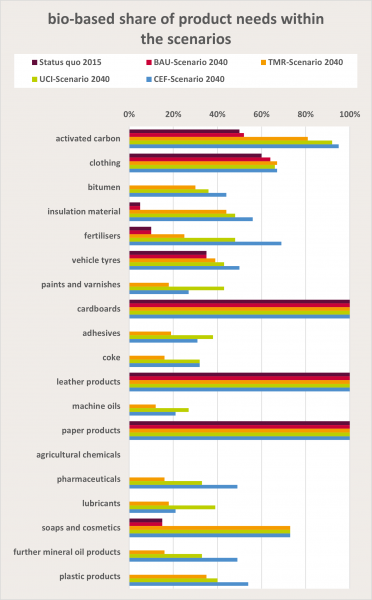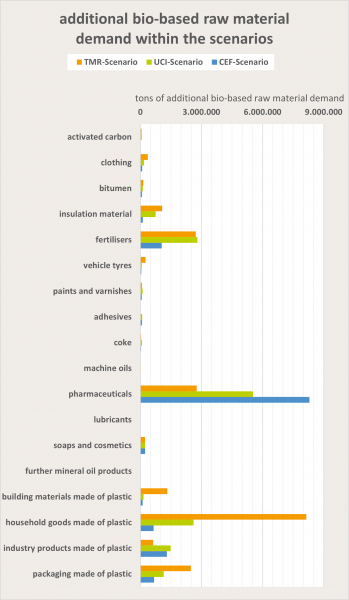Scenarios for the Biobased Industry in Austria
Short Description
These three scenarios cover different realistic transformation paths for the bio-based industry and are intended to significantly advance the discussion on strategy development within the bio-based industry and subsequently the bioeconomy.
These three scenarios focus on the...
- Promotion of bio-based technology paths that are already as mature as possible (TMR),
- Extension of the existing and possible bio-based utilization cascades (UCI) and
- Focus on a bio-based circular economy as much as possible (CEF).
A key result from the scenarios is how the bio-based shares develop within the considered product groups in the three scenarios (see Figure 1).
The TMR scenario (Technology & Market Readiness) shows the lowest bio-based shares, although these represent significant leaps upwards compared to the BAU scenario. The UCI scenario (Utilisation Cascades Increase) represents a further increase in terms of bio-based shares. In the CEF scenario (Circular Economy Focus), these shares decrease for some product groups and continues to increase for other groups. This is due to the fact that in the UCI scenario is more pressure to use bio-based raw materials due to the expansion of usage cascades. This is particularly evident in the product groups of paints and varnishes, adhesives, machine oils and lubricants, which, despite the generally higher bio-based content in the CEF scenario, have the higher specific bio-based content in the UCI scenario.
The additional bio-based raw material demands were calculated from the developed numerical model, the bio-based shares and the selected technology paths. In this context this means that in all three scenarios the difference to the BAU scenario (Business As Usual) was formed. Thus, nearly completely bio-based industrial sectors such as the paper industry have already been excluded.
Figure 2 shows that a high additional bio-based raw material demand for pharmaceuticals as well as for household goods, packaging, industrial products and building materials made of plastic is to be expected. Here, technology paths based on lignocellulose proved to be significantly more resource-efficient. Of course, closed raw material cycles also significantly reduce the required raw material consumption.
It should be emphasized that, for pharmaceuticals, for example, the calculated and illustrated raw material demand not only covers the approximately 14,000 tons of domestic consumption, but also the almost 102,000 tons of exports.
Other large quantities are required for the product groups of household goods, packaging, industrial products and building supplies made of plastic.
For the three scenarios, a range of 17,292 employees in the TMR scenario, 21,062 employees in the UCI scenario and 26,656 employees in the CEF scenario was calculated for the newly added bio-based industry. This number represents the employees in the bio-based industry in comparison to the BAU scenario. Whether and how many "conventional" employees will be eliminated in the respective industrial sector could not be determined using this generic approach and would require a sector-specific approach to be appropriate meaningful.
In addition, it was estimated that a range of greenhouse gas emission savings from 1.78 million CO2-equivalents in the TMR scenario, to 2.16 million CO2-equivalents in the UCI scenario, and up to 2.74 million CO2-equivalents in the CEF scenario scenario are possible. This corresponds 11 to 16% of the total current greenhouse gas emissions in industry in Austria, which could be saved by the addition of bio-based industry.
Contact Address
Ing. Thomas Steffl, MSc.
scenario editor e.U.
DIin (FH), Mag.a Veronika Reinberg
alchemia-nova GmbH


